早期淋巴结阴性三阴性乳腺癌术后化疗
乳腺癌三阴术后治疗方案

一、引言乳腺癌是全球女性最常见的恶性肿瘤之一,其发病率呈逐年上升趋势。
乳腺癌的治疗方法主要包括手术、放疗、化疗、内分泌治疗及靶向治疗等。
三阴乳腺癌(Triple-negative breast cancer,TNBC)是指雌激素受体(ER)、孕激素受体(PR)和人类表皮生长因子受体2(HER2)均为阴性的乳腺癌,约占乳腺癌患者的15-20%。
由于三阴乳腺癌缺乏特异性靶向治疗药物,治疗难度较大。
本文将对三阴乳腺癌术后治疗方案进行探讨。
二、治疗方案1. 手术治疗(1)保乳手术:对于早期三阴乳腺癌患者,可考虑保乳手术,包括肿瘤切除、周围组织切除及腋窝淋巴结清扫。
术后需进行放疗,以降低复发风险。
(2)改良根治术:对于中晚期三阴乳腺癌患者,通常需进行改良根治术,包括肿瘤切除、周围组织切除、腋窝淋巴结清扫及乳腺切除术。
2. 放疗治疗(1)术后放疗:对于保乳手术后的患者,术后放疗可降低局部复发风险。
放疗剂量通常为50-60 Gy。
(2)辅助放疗:对于根治术后的患者,根据具体情况可考虑辅助放疗,以降低远处转移风险。
3. 化学治疗(1)新辅助化疗:对于可手术切除的三阴乳腺癌患者,新辅助化疗可缩小肿瘤体积,提高手术切除率。
化疗方案通常为蒽环类药物联合紫杉类药物。
(2)辅助化疗:对于术后患者,辅助化疗可降低复发风险。
化疗方案与新辅助化疗类似。
4. 内分泌治疗三阴乳腺癌缺乏雌激素受体和孕激素受体,因此内分泌治疗不是三阴乳腺癌的主要治疗方法。
但对于激素受体阳性的患者,内分泌治疗可作为辅助治疗手段。
5. 靶向治疗三阴乳腺癌缺乏HER2过度表达,因此靶向治疗不是三阴乳腺癌的主要治疗方法。
但对于HER2阳性的患者,靶向治疗可作为一种辅助治疗手段。
6. 综合治疗对于三阴乳腺癌患者,综合治疗是提高生存率的关键。
以下是一些建议:(1)定期复查:术后患者应定期进行复查,包括乳腺超声、乳腺钼靶、胸部CT等,以监测病情变化。
(2)心理支持:乳腺癌患者常伴有心理负担,家属和医护人员应给予患者足够的关爱和支持。
三阴性乳腺癌
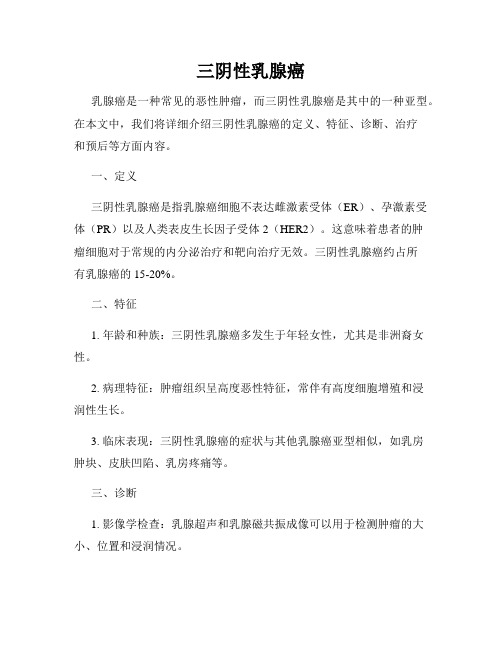
三阴性乳腺癌乳腺癌是一种常见的恶性肿瘤,而三阴性乳腺癌是其中的一种亚型。
在本文中,我们将详细介绍三阴性乳腺癌的定义、特征、诊断、治疗和预后等方面内容。
一、定义三阴性乳腺癌是指乳腺癌细胞不表达雌激素受体(ER)、孕激素受体(PR)以及人类表皮生长因子受体2(HER2)。
这意味着患者的肿瘤细胞对于常规的内分泌治疗和靶向治疗无效。
三阴性乳腺癌约占所有乳腺癌的15-20%。
二、特征1. 年龄和种族:三阴性乳腺癌多发生于年轻女性,尤其是非洲裔女性。
2. 病理特征:肿瘤组织呈高度恶性特征,常伴有高度细胞增殖和浸润性生长。
3. 临床表现:三阴性乳腺癌的症状与其他乳腺癌亚型相似,如乳房肿块、皮肤凹陷、乳房疼痛等。
三、诊断1. 影像学检查:乳腺超声和乳腺磁共振成像可以用于检测肿瘤的大小、位置和浸润情况。
2. 组织学检查:通过乳腺穿刺或活检,获取乳腺癌组织样本,进一步确定其亚型。
四、治疗由于三阴性乳腺癌对于内分泌治疗和靶向治疗无效,综合治疗是其主要治疗手段。
治疗常包括以下几个方面:1.手术治疗:乳腺癌的根治手术是首选,通常包括乳房保留手术和乳房切除术。
对于肿瘤较大或有淋巴结转移的患者,常结合腋窝淋巴结清扫术。
2.放疗:手术后常联合放疗,以减少局部复发的风险。
3.化疗:化疗对于三阴性乳腺癌的治疗起到重要作用。
常采用多药联合化疗,如TC(环磷酰胺+多柔比星)方案。
4.新辅助治疗:针对肿瘤较大或转移较多的患者,可采用新辅助化疗来缩小肿瘤体积,提高手术切除的可能性。
5.靶向治疗:尽管HER2阴性,但有一些患者可被转化为HER2阳性,从而受益于靶向治疗,如曲妥珠单抗等。
五、预后三阴性乳腺癌的预后较差,常伴有较高的复发率和短期内的转移风险。
然而,对于早期发现和积极治疗的患者,预后可能会有所改善。
目前的研究正致力于发现新的治疗方法以提高患者的生存率。
在总结中,三阴性乳腺癌是一种特殊的乳腺癌亚型,其临床特征和治疗方法与其他亚型不同。
三阴乳腺癌 治疗方法
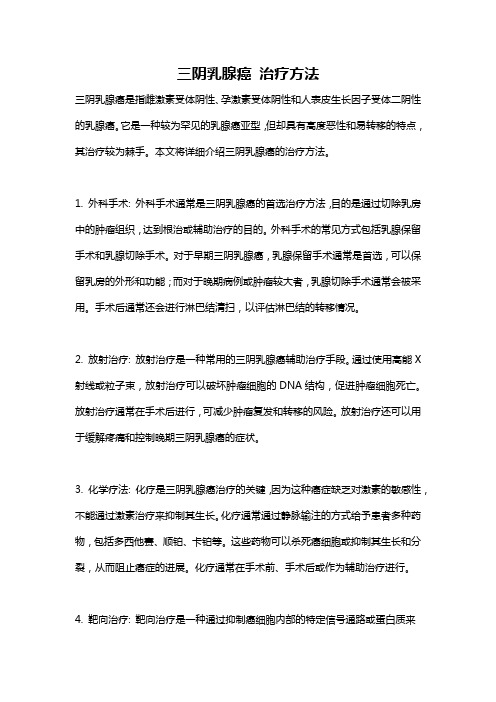
三阴乳腺癌治疗方法三阴乳腺癌是指雌激素受体阴性、孕激素受体阴性和人表皮生长因子受体二阴性的乳腺癌。
它是一种较为罕见的乳腺癌亚型,但却具有高度恶性和易转移的特点,其治疗较为棘手。
本文将详细介绍三阴乳腺癌的治疗方法。
1. 外科手术: 外科手术通常是三阴乳腺癌的首选治疗方法,目的是通过切除乳房中的肿瘤组织,达到根治或辅助治疗的目的。
外科手术的常见方式包括乳腺保留手术和乳腺切除手术。
对于早期三阴乳腺癌,乳腺保留手术通常是首选,可以保留乳房的外形和功能;而对于晚期病例或肿瘤较大者,乳腺切除手术通常会被采用。
手术后通常还会进行淋巴结清扫,以评估淋巴结的转移情况。
2. 放射治疗: 放射治疗是一种常用的三阴乳腺癌辅助治疗手段。
通过使用高能X 射线或粒子束,放射治疗可以破坏肿瘤细胞的DNA结构,促进肿瘤细胞死亡。
放射治疗通常在手术后进行,可减少肿瘤复发和转移的风险。
放射治疗还可以用于缓解疼痛和控制晚期三阴乳腺癌的症状。
3. 化学疗法: 化疗是三阴乳腺癌治疗的关键,因为这种癌症缺乏对激素的敏感性,不能通过激素治疗来抑制其生长。
化疗通常通过静脉输注的方式给予患者多种药物,包括多西他赛、顺铂、卡铂等。
这些药物可以杀死癌细胞或抑制其生长和分裂,从而阻止癌症的进展。
化疗通常在手术前、手术后或作为辅助治疗进行。
4. 靶向治疗: 靶向治疗是一种通过抑制癌细胞内部的特定信号通路或蛋白质来治疗癌症的方法。
对于三阴乳腺癌患者,一些细胞因子受体抑制剂或酪蛋白激酶抑制剂可以作为靶向治疗的选择。
例如,帕博利珠单抗、依泊利替尼等靶向治疗药物可以抑制人表皮生长因子受体的活性,从而阻断癌细胞的生长和扩散。
5. 免疫治疗: 免疫治疗是一种通过激活患者自身的免疫系统来攻击和杀死癌细胞的方法。
在三阴乳腺癌的治疗中,免疫检查点抑制剂通常被使用。
这些药物可以阻断肿瘤细胞释放的抑制性信号,从而激活免疫细胞攻击和杀死癌细胞。
然而,目前仍需要进一步的研究来确定免疫治疗在三阴乳腺癌中的作用和效果。
三阴性乳腺癌治疗方案

三阴性乳腺癌治疗方案引言三阴性乳腺癌是一种乳腺癌的亚型,其表示缺乏雌激素受体(ER)、孕激素受体(PR)以及人类表皮生长因子受体2(HER2)的表达。
尽管三阴性乳腺癌对于常规治疗不敏感,并有较高的复发率和短期生存期,但通过采用一系列综合治疗措施,可以提高患者的生存率和生活质量。
本文将探讨三阴性乳腺癌的治疗方案。
外科手术根据肿瘤的大小和淋巴结的侵犯情况,手术可能是三阴性乳腺癌治疗的首要选择。
常见的手术方式包括乳房保留手术(lumpectomy)和乳房切除手术(mastectomy)。
乳房保留手术主要通过切除肿瘤组织并保留乳房形态,患者术后可继续进行辅助治疗。
乳房切除手术则是完全切除整个乳房组织,有时还会伴随乳房重建手术。
手术后还可以考虑进行淋巴结清扫以确定是否有淋巴结转移。
放疗放疗是三阴性乳腺癌治疗中的重要组成部分。
在手术后,放疗可以帮助减少肿瘤复发的风险。
放疗通过照射乳房区域来杀灭潜在的肿瘤残留细胞。
通常,放疗会持续几周,每日进行治疗。
对于淋巴结转移的患者,放疗通常也会照射到淋巴结区域。
化疗由于三阴性乳腺癌缺乏靶向治疗的选择,化疗成为主要的治疗方式之一。
化疗通过使用药物来杀死癌细胞,并防止其扩散至其他部位。
根据患者的具体情况,可以使用多种化疗药物,如阿霉素、环磷酰胺、卡铂等。
化疗方案一般会持续数周或数月,具体剂量和用药方案需根据患者的情况而定。
靶向治疗对于一部分三阴性乳腺癌患者,HER2基因缺失也被证实,此时可以考虑使用靶向治疗药物。
例如,Trastuzumab是一种针对HER2阳性乳腺癌的治疗药物,通过抑制HER2信号通路的活性来抑制肿瘤的增长。
然而,在三阴性乳腺癌患者中,靶向治疗的选择非常有限,需要进一步的研究来开发新的靶向治疗策略。
免疫治疗免疫治疗是近年来在肿瘤治疗领域取得突破的一种方法。
针对三阴性乳腺癌,免疫检查点抑制剂如PD-1和PD-L1抑制剂已经显示出一定的疗效。
这些药物可以阻止肿瘤细胞利用抑制性信号躲避免疫系统的攻击,从而增强免疫细胞对癌细胞的杀伤能力。
三阴性乳腺癌治疗方案

乳腺癌是女性最常见的恶性肿瘤之一,而三阴性乳腺癌(Triple-negative breast cancer,TNBC)是指雌激素受体(ER)、孕激素受体(PR)和人表皮生长因子受体2(HER2)均为阴性的乳腺癌。
由于缺乏针对这些受体的靶向治疗药物,三阴性乳腺癌的治疗方案相对有限。
本文将详细介绍三阴性乳腺癌的治疗方案,包括手术、放疗、化疗、内分泌治疗和靶向治疗等。
二、手术治疗1. 手术目的(1)切除肿瘤,降低肿瘤负荷;(2)明确肿瘤分期,为后续治疗提供依据;(3)改善患者生活质量。
2. 手术方法(1)乳腺癌改良根治术:切除肿瘤、乳腺、腋窝淋巴结及部分胸壁肌肉;(2)乳腺癌保乳手术:切除肿瘤、乳腺部分及腋窝淋巴结;(3)乳腺癌改良根治术+前哨淋巴结活检:评估腋窝淋巴结是否转移,减少腋窝淋巴结清扫范围。
三、放疗1. 放疗目的(1)降低局部复发风险;(2)改善局部症状;(3)提高生存率。
2. 放疗方法(1)全乳放疗:适用于乳腺癌改良根治术、保乳手术后的患者;(2)区域淋巴结放疗:适用于腋窝淋巴结阳性或高危患者;(3)胸壁放疗:适用于局部复发或胸壁受侵的患者。
1. 化疗目的(1)降低肿瘤负荷;(2)降低远处转移风险;(3)提高生存率。
2. 化疗方案(1)蒽环类药物+紫杉类药物:如蒽环类药物+紫杉类药物+卡培他滨;(2) Taxotere方案:多西他赛+环磷酰胺;(3)CapeOx方案:卡培他滨+奥沙利铂。
化疗方案的选择应根据患者的具体情况、肿瘤分期和治疗方案的效果进行个体化调整。
五、内分泌治疗由于三阴性乳腺癌缺乏雌激素受体,内分泌治疗的效果有限。
但在某些情况下,如伴有HER2阳性的三阴性乳腺癌,可以考虑使用抗雌激素药物如氟维司群(Fulvestrant)进行治疗。
六、靶向治疗1. 靶向治疗目的(1)降低肿瘤负荷;(2)降低远处转移风险;(3)提高生存率。
2. 靶向治疗药物(1)Herceptin(曲妥珠单抗):适用于HER2阳性的三阴性乳腺癌;(2)Tykerb(拉帕替尼):适用于HER2阳性的三阴性乳腺癌;(3)Ibrance(帕博利珠单抗):适用于HER2阳性的三阴性乳腺癌。
三阴性乳腺癌的病理特征及临床预后探讨

三阴性乳腺癌的病理特征及临床预后探讨三阴性乳腺癌是指乳腺癌中缺乏表达雌激素受体(ER)、孕激素受体(PR)和人类表皮生长因子受体2(HER2)的一种亚型,它占乳腺癌总发病率的10%至20%左右,目前被认为是乳腺癌中最具有异质性和最具有挑战性的亚型之一。
三阴性乳腺癌的病理特征和临床预后一直备受关注和研究。
本文将对其病理特征和临床预后进行探讨。
一、病理特征1.肿瘤形态学特征三阴性乳腺癌通常呈现高度异型性,具有高度浸润性和侵袭性,形态多变,常见的有实性、糜烂性、团块状、瘢痕性等多种形态。
肿瘤细胞核分裂相、细胞间质增生明显,边缘模糊,含微小的核分裂象,是典型的恶性肿瘤生长特征。
2.分子特征三阴性乳腺癌主要以基底样亚型和浸润性导管癌为主,具有高度异质性,主要由肿瘤干细胞、浆细胞、上皮细胞、肌上皮细胞等多种细胞类型组成。
该亚型缺乏ER、PR和HER2的表达,通常表现为蛋白水平的缺失或基因的缺失,这就使得三阴性乳腺癌对内分泌治疗、靶向治疗等多种治疗手段无效。
3.免疫组织化学特征三阴性乳腺癌通常更年轻化,患者年龄在40岁以下者占到一半以上,肿瘤生长快,侵犯淋巴管径路和血管,同时也因为缺乏ER和PR的表达而使得其亚型对激素治疗无效。
此外,三阴性乳腺癌还有和BRCA1突变有关的遗传背景,肿瘤细胞具备更高的增殖能力和更强的DNA损伤修复能力。
二、临床预后一般而言,三阴性乳腺癌较其它亚型的发生率更快、复发率更高,疗效评估也较为困难。
化疗和手术治疗是目前唯一可行的治疗手段,然而三阴性乳腺癌不同于其他亚型,不像HER2过表达的乳腺癌或ER/PR阳性的乳腺癌可以使用靶向药物和内分泌治疗,对于三阴性乳腺癌的处理要强调病理特征和体征诊断。
1.预后指标三阴性乳腺癌疾病预后因人而异,其中最重要的决定因素是病人的年龄、肿瘤分期和治疗方式等。
(1)肿瘤分期:三阴性乳腺癌的分期是预测疾病预后的重要指标,肿瘤分期越早,预后越好。
(2)淋巴结转移情况:淋巴结转移是三阴性乳腺癌的一项重要特征,淋巴结转移越多,预后越差。
乳腺癌化疗

仁心 仁术 创新 奉献
(五)内分泌治疗 1.辅助内分泌治疗 (1)适应证 1)激素受体ER和或PR阳性的浸润性乳腺癌患者。 2)原位癌患者如出现以下情况可考虑行5年内分泌治疗:①保乳手术后需要放 疗患者,特别是其中激素受体阳性的导管原位癌;②仅行局部切除导管原位 癌患者;③行乳腺全切患者,用于预防对侧乳腺癌发生。 (2)禁忌证 1)使用内分泌药物有禁忌的患者:有深部静脉血栓或肺栓塞史者。 2)严重肝肾功能损伤者慎用。 3)孕妇及既往应用内分泌治疗药物过敏者。
8
仁术 创新 奉献
(4)注意事项。 1)化疗前必须对乳腺原发灶行空芯针活检明确组织学诊断及免疫组化检查, 区域淋巴结转移可以釆用细胞学诊断。 2)明确病理组织学诊断后实施新辅助化疗。 3)不建议Ⅰ期患者选择新辅助化疗。 4)一般周期数为4~8周期,在治疗有反应或疾病稳定的患者中,推荐手术前 用完所有的既定周期数。 5)应从体检和影像学2个方面评价乳腺原发灶和腋窝淋巴结转移灶疗效,按照 实体肿瘤疗效评估疗效。 6)无效时暂停该化疗方案,改用手术、放射治疗或者其他全身治疗措施(更换 化疗方案或改行新辅助内分泌治疗)。 7)新辅助化疗后,即便临床上肿瘤完全消失,也必须接受既定的后续手术治 疗,根据个体情况选择乳腺癌根治术、乳腺癌改良根治术或保留乳房手术。 8)术后辅助化疗应根据术前新辅助化疗的周期、疗效及术后病理检查结果确 定治疗方案。 9)推荐根据化疗前的肿瘤临床分期来决定是否需要辅助放疗及放疗范围。
常用的单药包括:紫杉醇、多西他赛、白蛋白结合型紫杉醇、卡培他滨、长春瑞滨、吉西他滨、 多柔比星脂质体等;依托泊苷胶囊、环磷酰胺片等口服方便,可以作为后线治疗的选择。
11
仁心 仁术 创新 奉献
2)联合化疗 适合病情进展较快,肿瘤负荷较大或症状明显的患者。联合化疗方案的选择应参考 既往辅助化疗用药,化疗结束时间,目前患者的身体和经济条件等因素综合考量。 a.对既往未用过化疗者,首先考虑蒽环联合紫杉类药物。蒽环类治疗失败或达累积 剂量者,优先选择紫杉类为基础的药物。辅助治疗用过紫杉类,距离复发时间大于 1年者,可以再次使用,优选未用过的药物。紫杉类联合吉西他滨或卡培他滨是一 线治疗最常用的方案。既往使用过蒽环及紫杉类治疗失败者,可考虑含卡培他滨、 长春瑞滨或吉西他滨等的联合方案。 b.—线化疗进展后,可以根据患者的耐受性,病变范围,既往治疗的疗效和毒性个 体化的选择没有交叉耐药的单药或联合方案。对既往治疗有效,疾病控制时间较长 的药物,后线治疗仍然可以再次应用。 c.对多程化疗失败的患者无标准治疗,鼓励患者参加新药临床试验或对症支持治疗。 d.对HER2阳性患者,化疗同时应联合抗HER2靶向药物,如曲妥珠单抗,拉帕替尼 等。
三阴性乳腺癌又添新方案
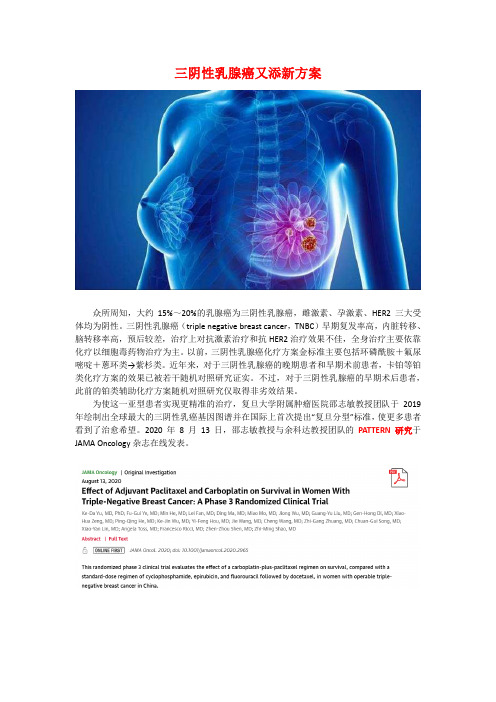
三阴性乳腺癌又添新方案众所周知,大约15%~20%的乳腺癌为三阴性乳腺癌,雌激素、孕激素、HER2三大受体均为阴性。
三阴性乳腺癌(triple negative breast cancer,TNBC)早期复发率高,内脏转移、脑转移率高,预后较差,治疗上对抗激素治疗和抗HER2治疗效果不佳,全身治疗主要依靠化疗以细胞毒药物治疗为主。
以前,三阴性乳腺癌化疗方案金标准主要包括环磷酰胺+氟尿嘧啶+蒽环类→紫杉类。
近年来,对于三阴性乳腺癌的晚期患者和早期术前患者,卡铂等铂类化疗方案的效果已被若干随机对照研究证实。
不过,对于三阴性乳腺癌的早期术后患者,此前的铂类辅助化疗方案随机对照研究仅取得非劣效结果。
为使这一亚型患者实现更精准的治疗,复旦大学附属肿瘤医院邵志敏教授团队于2019年绘制出全球最大的三阴性乳癌基因图谱并在国际上首次提出“复旦分型”标准,使更多患者看到了治愈希望。
2020年8月13日,邵志敏教授与余科达教授团队的PATTERN研究于JAMA Oncology杂志在线发表。
PATTERN研究探索了卡铂联合紫杉醇(PCb)对比当时指南推荐的CEF-T方案在早期TNBC 术后辅助治疗中的价值。
与CEF-T方案相比,PCb方案将早期可手术TNBC 5年的DFS提高了6.2%(86.5% vs 80.3%,HR=0.65,95%CI:0.44~0.96,P=0.03),确认了铂类在TNBC辅助治疗中优效性地位。
该多中心非盲随机对照三期临床研究于2011年7月1日~2016年4月30日从全国9家医院入组三阴性乳腺癌尚未转移、非局部晚期、术前尚未接受抗癌治疗、术后经病理证实区域淋巴结阳性或淋巴结阴性但肿瘤直径大于1厘米、年龄18~70岁(中位51岁,四分位44~57岁,范围23~70岁)女性647例,按1∶1的比例随机分为两组:卡铂方案组325例:6轮紫杉醇+卡铂(每28天的第1、8、15天紫杉醇80mg/m²+卡铂AUC=2)标准方案组322例:3轮环磷酰胺+表柔比星+氟尿嘧啶(每3周环磷酰胺500mg/m²+表柔比星100mg/m²+氟尿嘧啶500mg/m²)→3轮多西他赛(每3周多西他赛100mg/m ²)数据分析于2019年12月1日~2020年1月31日,主要终点为无病生存,次要终点包括总生存、无远处病变生存、无复发生存、毒性反应。
三阴乳腺癌三期治疗方案

一、引言乳腺癌是我国女性常见的恶性肿瘤之一,其发病率逐年上升。
三阴乳腺癌(Triple-negative breast cancer,TNBC)是指雌激素受体(ER)、孕激素受体(PR)和人类表皮生长因子受体2(HER2)均为阴性的乳腺癌,占所有乳腺癌的15%-20%。
由于缺乏特异性靶向治疗,三阴乳腺癌的治疗较为困难。
本文将对三阴乳腺癌三期的治疗方案进行综述。
二、治疗方案1. 手术治疗(1)新辅助化疗:对于可手术的三阴乳腺癌患者,新辅助化疗是一种重要的治疗手段。
新辅助化疗的目的是缩小肿瘤体积,提高手术切除的可行性,降低局部复发风险。
常用方案包括紫杉醇联合卡铂或蒽环类药物。
(2)手术治疗:手术方式包括保乳手术和改良根治术。
保乳手术适用于肿瘤直径小于3cm、腋窝淋巴结阴性或仅1-2个淋巴结阳性的患者。
改良根治术适用于肿瘤直径大于3cm或腋窝淋巴结阳性的患者。
2. 辅助化疗(1)多周期化疗:三阴乳腺癌患者常采用多周期化疗方案,如紫杉醇联合卡铂或蒽环类药物。
紫杉醇联合卡铂方案的总生存期(OS)和无病生存期(DFS)优于单药化疗。
蒽环类药物联合紫杉醇方案也是三阴乳腺癌治疗的有效方案。
(2)联合靶向治疗:近年来,针对三阴乳腺癌的靶向治疗取得了显著进展。
如帕博利珠单抗(Pembrolizumab)和尼伐单抗(Nivolumab)等免疫检查点抑制剂。
联合靶向治疗可以提高化疗效果,降低复发风险。
3. 辅助放疗(1)术前放疗:对于局部晚期或侵犯胸壁的三阴乳腺癌患者,术前放疗可以缩小肿瘤体积,提高手术切除的可行性。
(2)术后放疗:对于保乳手术后的患者,术后放疗可以降低局部复发风险。
放疗剂量通常为50-60Gy。
4. 内分泌治疗三阴乳腺癌患者缺乏雌激素受体和孕激素受体,因此内分泌治疗对三阴乳腺癌的疗效有限。
但对于绝经后患者,可以考虑使用芳香化酶抑制剂(如阿那曲唑)或选择性雌激素受体调节剂(如依维莫司)。
5. 靶向治疗(1)免疫治疗:如帕博利珠单抗和尼伐单抗等免疫检查点抑制剂,可以联合化疗或放疗使用。
三阴性乳腺癌术后同侧锁骨上淋巴结转移同步放化疗的疗效分析
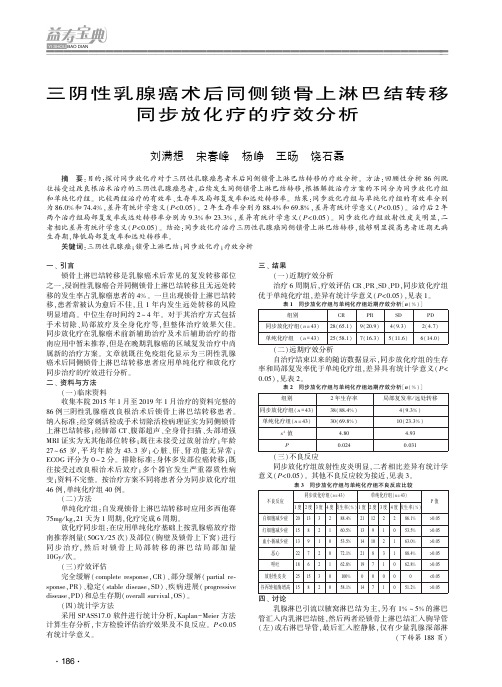
断敏感性较高。 彩色多普勒 B 超可检出乳腺内较粗大的较
高密度的钙化,呈强回声的点状,颗粒状光点,后方可伴光
点。 乳腺内低密度的细小钙化,不易检出。 彩色多普勒 B 超
对细微钙化敏感性较为微弱。 针对多量腺体型及致密型乳
腺而言,彩色多普勒 B 超对于小结节、小肿块的检出率要高
86 例三阴性乳腺癌改良根治术后锁骨上淋巴结转移患者。
纳入标准:经穿刺活检或手术切除活检病理证实为同侧锁骨
上淋巴结转移;经肺部 CT、腹部超声、全身骨扫描、头部增强
MRI 证实为无其他部位转移;既往未接受过放射治疗;年龄
27 ~ 65 岁, 平 均 年 龄 为 43. 3 岁; 心 脏、 肝、 肾 功 能 无 异 常;
<0.05
>0.05
四、 讨论
乳腺淋巴引流以腋窝淋巴结为主,另有 1% ~ 5% 的淋巴
管汇入内乳淋巴结链,然后两者经锁骨上淋巴结汇入胸导管
( 左) 或右淋巴导管,最后汇入腔静脉,仅有少量乳腺深部淋
( 下转第 188 页)
巴液经腹直肌鞘及肝圆韧带的淋巴管入肝脏。 乳腺癌锁骨
上淋巴结转移是乳腺癌术后常见的转移形式,尽管近期治疗
效果较为明显,但远期治疗效果仍不太理想。 大部分乳腺癌
对化疗和放疗较为敏感,对于身体情况较好的患者可以接受
更为综合的治疗。 放疗技术在治疗乳腺癌、鼻咽癌、食管癌
的局部疗效方面已经得到确切的证实。 但是放疗与化疗同
组别
2 年生存率
局部复发率 / 远处转移
30(69.8% )
10(23.3% )
0.024
0.031
同步放化疗组( n = 43)
乳腺癌三阴早期治疗方案

摘要:乳腺癌是我国女性最常见的恶性肿瘤之一,其中三阴性乳腺癌(TNBC)具有侵袭性强、预后差等特点。
本文针对乳腺癌三阴早期,从手术、化疗、靶向治疗、内分泌治疗等方面,探讨综合治疗方案,以期为临床治疗提供参考。
一、引言乳腺癌是我国女性最常见的恶性肿瘤之一,其发病率和死亡率呈逐年上升趋势。
三阴性乳腺癌(Triple-negative breast cancer,TNBC)是指雌激素受体(ER)、孕激素受体(PR)和人类表皮生长因子受体2(HER2)均为阴性的乳腺癌。
TNBC约占乳腺癌的15%-20%,具有侵袭性强、预后差、复发率高、对内分泌治疗和靶向治疗不敏感等特点。
因此,针对TNBC的综合治疗显得尤为重要。
二、治疗方案1. 手术治疗(1)乳腺癌根治术:适用于早期TNBC患者,手术切除肿瘤及周围组织,包括乳房、胸大肌、胸小肌、腋窝淋巴结等。
(2)乳腺癌保乳术:适用于肿瘤较小、位于乳房外上象限、无远处转移的早期TNBC患者,切除肿瘤及周围部分乳腺组织,保留乳房。
2. 化疗治疗(1)新辅助化疗:在手术前进行化疗,旨在缩小肿瘤、降低肿瘤分期、提高手术切除率。
常用的化疗方案有:1)蒽环类药物+紫杉类药物:如蒽环类药物(多西他赛、表阿霉素等)+紫杉类药物(紫杉醇、白蛋白紫杉醇等)。
2)蒽环类药物+卡铂:如蒽环类药物+卡铂。
(2)辅助化疗:在手术切除肿瘤后进行化疗,旨在杀灭残存的肿瘤细胞,降低复发率。
化疗方案与新辅助化疗类似。
3. 靶向治疗TNBC对靶向治疗不敏感,目前尚无针对TNBC的靶向治疗药物。
然而,随着研究的深入,以下靶向治疗药物在TNBC治疗中具有潜在应用价值:(1)抗HER2抗体偶联药物:如T-DM1。
(2)抗PD-1/PD-L1抗体:如帕博利珠单抗、尼伏单抗等。
4. 内分泌治疗TNBC对内分泌治疗不敏感,因此,内分泌治疗在TNBC治疗中的应用有限。
三、综合治疗方案针对TNBC的综合治疗方案主要包括:1. 手术治疗:根据患者的病情和意愿,选择乳腺癌根治术或保乳术。
188.)宋鑫:一例三阴乳腺癌患者的术后辅助化疗方案分析

一例三阴乳腺癌患者的术后辅助化疗方案分析宋鑫1,3黄立峰1余宗阳21、南京军区福州总医院药学科;2、南京军区福州总医院肿瘤科,福建福州350025;3、福建南平92医院药械科,福建南平353000摘要:本文通过查阅文献和学习治疗指南,从化疗的适应症与禁忌症、方案选择及药物作用特点等方面,对一例三阴乳腺癌(TNBC)患者的术后辅助化疗方案进行分析和学习,增加抗肿瘤药物的临床应用知识,提高参与肿瘤内科治疗的临床药学分析能力和服务技能。
关键词:临床药学;乳腺癌;化学治疗1病史摘要患者,女,34岁, 2011年01月行“左乳改良根治术”,术后病理:乳腺浸润性癌,周围乳腺呈纤维腺病改变;乳头及皮肤、乳腺基底、手术残腔均未见癌累及;检出腋窝淋巴结(19枚)未见癌转移。
免疫组化:ER(-),PR(-),Her-2(-),乳腺基底细胞样癌,分期T1cNOM0,I期,2011年2月住院期间行“吉西他滨1000 mg d1、8+顺铂40 mg d2-4×Q21d”方案化疗一周期,期间出现Ⅱ度骨髓抑制和胃肠道反应,积极配合制酸、止吐、保肝等对症支持处理,临床症状得以改善。
2化疗方案分析2.1乳腺癌术后辅助化疗目前,术后辅助化疗是乳腺癌综合治疗的重要组成部分,是否给予辅助化疗与淋巴结状况有关,特别是对淋巴结阴性的患者,要看是否有复发的高危因素存在。
一般认为,患者年龄小于35岁、肿瘤直径大于2.0cm、核分级为Ⅲ级、脉管癌栓、ER阴性、HER-2基因高表达及S期细胞明显增加的患者患者应考虑给予术后辅助化疗。
该患者ER为阴性,且年龄<35岁,属可复发中高危患者,应考虑给予术后辅助化疗。
三阴乳腺癌(TNBC)是指雌激素受体(ER)、孕激素受体(PR)、人类表皮生长因子受体(HER-2)均为阴性表达的乳腺癌,因其临床生物学行为侵袭性强、复发早、进展快、生存短等特点引起越来越多的重视[1]。
2.2三阴乳腺癌的术后辅助化疗方案分析由于三阴乳腺癌具有相对独立的病理分型,在方案选择方面,内分泌治疗以及针对HER-2的分子靶向治疗均不能使患者从中受益,治疗方案主要参考普通乳腺癌的方案。
三阴性乳腺癌
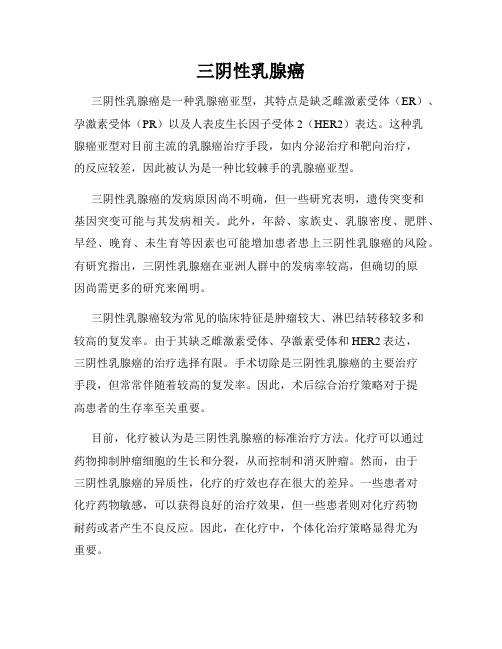
三阴性乳腺癌三阴性乳腺癌是一种乳腺癌亚型,其特点是缺乏雌激素受体(ER)、孕激素受体(PR)以及人表皮生长因子受体2(HER2)表达。
这种乳腺癌亚型对目前主流的乳腺癌治疗手段,如内分泌治疗和靶向治疗,的反应较差,因此被认为是一种比较棘手的乳腺癌亚型。
三阴性乳腺癌的发病原因尚不明确,但一些研究表明,遗传突变和基因突变可能与其发病相关。
此外,年龄、家族史、乳腺密度、肥胖、早经、晚育、未生育等因素也可能增加患者患上三阴性乳腺癌的风险。
有研究指出,三阴性乳腺癌在亚洲人群中的发病率较高,但确切的原因尚需更多的研究来阐明。
三阴性乳腺癌较为常见的临床特征是肿瘤较大、淋巴结转移较多和较高的复发率。
由于其缺乏雌激素受体、孕激素受体和HER2表达,三阴性乳腺癌的治疗选择有限。
手术切除是三阴性乳腺癌的主要治疗手段,但常常伴随着较高的复发率。
因此,术后综合治疗策略对于提高患者的生存率至关重要。
目前,化疗被认为是三阴性乳腺癌的标准治疗方法。
化疗可以通过药物抑制肿瘤细胞的生长和分裂,从而控制和消灭肿瘤。
然而,由于三阴性乳腺癌的异质性,化疗的疗效也存在很大的差异。
一些患者对化疗药物敏感,可以获得良好的治疗效果,但一些患者则对化疗药物耐药或者产生不良反应。
因此,在化疗中,个体化治疗策略显得尤为重要。
近年来,免疫治疗成为三阴性乳腺癌研究的热点之一。
免疫治疗通过激活患者自身的免疫系统,增强对肿瘤细胞的攻击能力。
目前,研究人员正在积极寻找能够有效治疗三阴性乳腺癌的免疫治疗方法。
一些早期的研究已经显示,免疫检查点抑制剂在三阴性乳腺癌的治疗中具有一定的疗效,但仍需要进一步的研究来探索其潜力。
除了化疗和免疫治疗,放射治疗也是三阴性乳腺癌综合治疗的重要组成部分。
放射治疗可以通过靶向肿瘤区域释放高能量射线,杀灭残留的肿瘤细胞,从而减少复发的风险。
然而,对于三阴性乳腺癌来说,放射治疗的适应症和疗效仍存在争议,需要进一步的研究来明确。
总体来说,三阴性乳腺癌是一种比较复杂且难治的乳腺癌亚型。
齐元富教授治疗三阴性乳腺癌临证经验
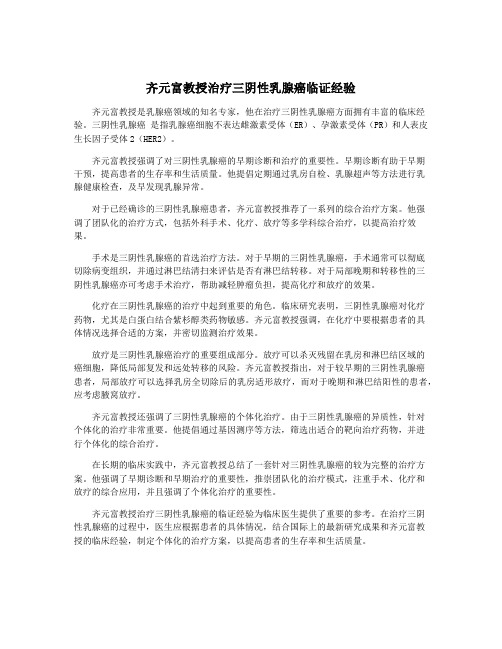
齐元富教授治疗三阴性乳腺癌临证经验齐元富教授是乳腺癌领域的知名专家,他在治疗三阴性乳腺癌方面拥有丰富的临床经验。
三阴性乳腺癌是指乳腺癌细胞不表达雌激素受体(ER)、孕激素受体(PR)和人表皮生长因子受体2(HER2)。
齐元富教授强调了对三阴性乳腺癌的早期诊断和治疗的重要性。
早期诊断有助于早期干预,提高患者的生存率和生活质量。
他提倡定期通过乳房自检、乳腺超声等方法进行乳腺健康检查,及早发现乳腺异常。
对于已经确诊的三阴性乳腺癌患者,齐元富教授推荐了一系列的综合治疗方案。
他强调了团队化的治疗方式,包括外科手术、化疗、放疗等多学科综合治疗,以提高治疗效果。
手术是三阴性乳腺癌的首选治疗方法。
对于早期的三阴性乳腺癌,手术通常可以彻底切除病变组织,并通过淋巴结清扫来评估是否有淋巴结转移。
对于局部晚期和转移性的三阴性乳腺癌亦可考虑手术治疗,帮助减轻肿瘤负担,提高化疗和放疗的效果。
化疗在三阴性乳腺癌的治疗中起到重要的角色。
临床研究表明,三阴性乳腺癌对化疗药物,尤其是白蛋白结合紫杉醇类药物敏感。
齐元富教授强调,在化疗中要根据患者的具体情况选择合适的方案,并密切监测治疗效果。
放疗是三阴性乳腺癌治疗的重要组成部分。
放疗可以杀灭残留在乳房和淋巴结区域的癌细胞,降低局部复发和远处转移的风险。
齐元富教授指出,对于较早期的三阴性乳腺癌患者,局部放疗可以选择乳房全切除后的乳房适形放疗,而对于晚期和淋巴结阳性的患者,应考虑腋窝放疗。
齐元富教授还强调了三阴性乳腺癌的个体化治疗。
由于三阴性乳腺癌的异质性,针对个体化的治疗非常重要。
他提倡通过基因测序等方法,筛选出适合的靶向治疗药物,并进行个体化的综合治疗。
在长期的临床实践中,齐元富教授总结了一套针对三阴性乳腺癌的较为完整的治疗方案。
他强调了早期诊断和早期治疗的重要性,推崇团队化的治疗模式,注重手术、化疗和放疗的综合应用,并且强调了个体化治疗的重要性。
齐元富教授治疗三阴性乳腺癌的临证经验为临床医生提供了重要的参考。
NCCN乳腺癌化疗方案
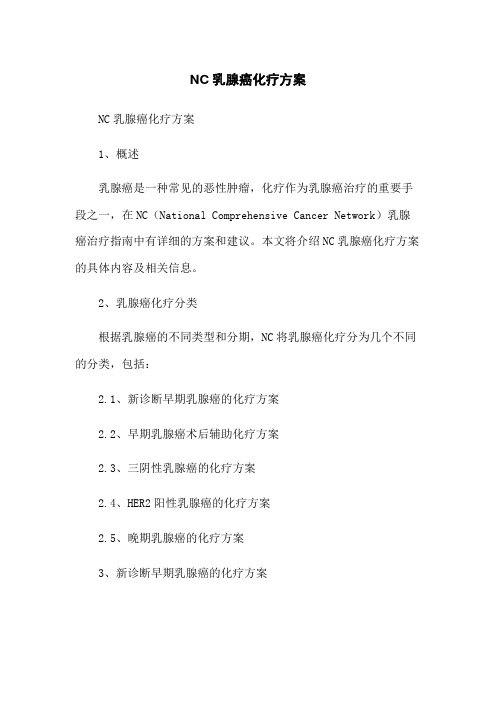
NC乳腺癌化疗方案NC乳腺癌化疗方案1、概述乳腺癌是一种常见的恶性肿瘤,化疗作为乳腺癌治疗的重要手段之一,在NC(National Comprehensive Cancer Network)乳腺癌治疗指南中有详细的方案和建议。
本文将介绍NC乳腺癌化疗方案的具体内容及相关信息。
2、乳腺癌化疗分类根据乳腺癌的不同类型和分期,NC将乳腺癌化疗分为几个不同的分类,包括:2.1、新诊断早期乳腺癌的化疗方案2.2、早期乳腺癌术后辅助化疗方案2.3、三阴性乳腺癌的化疗方案2.4、HER2阳性乳腺癌的化疗方案2.5、晚期乳腺癌的化疗方案3、新诊断早期乳腺癌的化疗方案对于新诊断的早期乳腺癌患者,NC建议根据患者的具体情况选择合适的化疗方案,包括药物选择、治疗周期和剂量等方面。
4、早期乳腺癌术后辅助化疗方案对于早期乳腺癌手术后的辅助化疗,NC建议根据病理结果、患者年龄、分子分型和乳腺癌的分期等因素,选择合适的化疗方案和药物,以降低复发的风险。
5、三阴性乳腺癌的化疗方案三阴性乳腺癌是一种具有侵袭性和较差预后的乳腺癌类型。
NC推荐的化疗方案主要包括使用含有类脱氧胸腺嘧啶(Capecitabine)的方案,或者联合使用顺铂(Cisplatin)和多西他赛(Docetaxel)等药物进行化疗。
6、HER2阳性乳腺癌的化疗方案HER2阳性乳腺癌是一种与HER2过表达有关的乳腺癌类型。
NC推荐的化疗方案主要包括使用含有曲妥珠单抗(Trastuzumab)和培美曲塞(Pertuzumab)的方案,或者联合使用多西他赛和曲妥珠单抗等药物进行化疗。
7、晚期乳腺癌的化疗方案对于晚期乳腺癌患者,NC推荐的化疗方案主要包括使用多西他赛和曲妥珠单抗等药物进行化疗。
此外,根据患者的具体情况,还可以考虑联合使用其他药物或放疗等治疗手段。
附件:本文档所涉及的附件包括:- 乳腺癌化疗药物清单:列出了常用的乳腺癌化疗药物及其相关信息,供医生和患者参考。
三阴性乳腺癌的化疗方案

三阴性乳腺癌的化疗方案简介三阴性乳腺癌是一种缺乏雌激素受体(ER)、孕激素受体(PR)和人表皮生长因子受体2(HER2)的癌症类型。
由于缺乏这些受体,三阴性乳腺癌对内分泌治疗和靶向治疗无效,因此通常采用化疗作为主要的治疗方式。
本文将介绍三阴性乳腺癌的化疗方案。
1. 新辅助化疗新辅助化疗是指在手术前先行化疗,目的是缩小肿瘤的体积,使手术更容易进行。
对于三阴性乳腺癌患者来说,新辅助化疗也可以评估肿瘤对化疗的敏感性,从而确定进一步的治疗方案。
药物选择新辅助化疗常使用的药物包括:•蒽环类药物(如阿霉素、紫杉醇):这些药物可干扰DNA的复制和细胞分裂,从而杀死癌细胞。
•白蛋白结合型紫杉醇(nab-紫杉醇):相比普通紫杉醇,nab-紫杉醇能更好地渗透进癌细胞并释放药物。
•单克隆抗体:如贝伐单抗,通过靶向HER2来抑制三阴性乳腺癌细胞的增殖。
•氟尿嘧啶类药物:如卡铂和顺铂,通过抑制DNA的合成来抑制癌细胞的生长。
化疗方案常用的新辅助化疗方案有:•AC-T方案:包括阿霉素和环磷酰胺的联合方案(AC)和紫杉醇的辅助方案(T)。
•TC方案:包括环磷酰胺和紫杉醇的联合方案。
•TAC方案:包括紫杉醇、阿霉素和环磷酰胺的联合方案。
这些方案均需要在专业医生的监督下进行,治疗周期通常为每三周一次,共进行6-8个周期。
患者在化疗期间可能会出现不良反应,如恶心、呕吐、脱发等,医生会根据个体情况给予相应的支持性治疗。
2. 辅助化疗辅助化疗是指在手术后进行化疗,以防止肿瘤的复发和转移。
对于三阴性乳腺癌患者来说,辅助化疗也可以减少微转移的风险,并提高无瘤存活率。
药物选择常用的辅助化疗药物与新辅助化疗相似,包括:•蒽环类药物(如阿霉素、紫杉醇)。
•白蛋白结合型紫杉醇。
•单克隆抗体(如贝伐单抗)。
•氟尿嘧啶类药物(如卡铂和顺铂)。
化疗方案辅助化疗的常见方案有:•AC-T方案:包括阿霉素和环磷酰胺的联合方案(AC)和紫杉醇的辅助方案(T)。
年轻女性三阴性乳腺癌局部复发病例分享病理学检查影像学检查表现及保乳治疗

年轻女性三阴性乳腺癌局部复发病例分享病理学检查影像学检查表现及保乳治疗乳腺癌是女性最常见的恶性肿瘤之一,而三阴性乳腺癌是一种特殊类型的乳腺癌。
本文将分享一位年轻女性患者的三阴性乳腺癌局部复发病例,并探讨病理学检查、影像学检查表现,以及保乳治疗的可行性。
1. 患者概况本病例的患者为一位27岁的年轻女性,既往无乳腺癌家族史。
三年前,她被确诊为右侧三阴性乳腺癌,并接受了化疗、手术及放疗治疗。
此次就诊是因为右侧乳房出现异常症状,并经医生检查后证实为局部复发。
2. 病理学检查针对局部复发的病变,进行了病理学检查。
结果显示肿瘤细胞呈高分化,并具有浸润性生长模式。
免疫组化染色显示肿瘤细胞表达CK5/6、EGFR和P63,而不表达雌激素受体(ER)、孕激素受体(PR)和人类表皮生长因子受体2(HER2)。
这些结果表明该病例为三阴性乳腺癌的局部复发。
3. 影像学检查表现为了评估局部复发的病变范围,患者接受了乳腺影像学检查。
乳腺超声显示右侧乳房中央位置有一个大小为2厘米的实性结节,边缘清晰,边界规整。
乳腺X线摄影及磁共振成像进一步确认了该结节,未显示有肺、肝、骨骼等远处转移。
4. 保乳治疗考虑到患者的年龄和肿瘤的特点,我们与患者共同决定进行保乳治疗。
手术方面,患侧乳房进行了切除肿瘤的手术,同时进行了腋窝淋巴结清扫术。
术后病理学检查确认肿瘤为三阴性乳腺癌,边缘未见癌细胞残留。
5. 辅助治疗患者在手术后接受了放疗和化疗,以进一步减少复发和转移的风险。
放疗方面,切除后区域接受了局部放疗,共进行了5周的治疗。
化疗方面,患者接受了顺铂、环磷酰胺和多西他赛的方案治疗,共进行了6个周期。
6. 随访结果截至目前,患者完成了所有的治疗并进入了随访期。
在术后1年的随访中,乳房切口愈合良好,未见局部复发或远处转移。
定期的乳腺超声及全身CT扫描也未显示出异常情况。
结语通过这个年轻女性三阴性乳腺癌局部复发病例的分享,我们了解到三阴性乳腺癌的复发可以发生在不同年龄阶段,但保乳治疗在适用的患者中是可行的。
- 1、下载文档前请自行甄别文档内容的完整性,平台不提供额外的编辑、内容补充、找答案等附加服务。
- 2、"仅部分预览"的文档,不可在线预览部分如存在完整性等问题,可反馈申请退款(可完整预览的文档不适用该条件!)。
- 3、如文档侵犯您的权益,请联系客服反馈,我们会尽快为您处理(人工客服工作时间:9:00-18:30)。
早期淋巴结阴性三阴性乳腺癌术后化疗
现有指南推荐对肿瘤>5毫米(T1b期)淋巴结阴性三阴性乳腺癌患者进行术后辅助化疗,不过支持该推荐意见的临床证据较少。
2020年7月25日,美国癌症学会《癌症》中国乳腺癌特刊在线发表中国肿瘤医学协同创新中心、中山大学附属肿瘤医院、昆明医科大学第二附属医院、法国马赛大学保利卡梅特斯癌症研究中心的临床研究和已发表文献荟萃分析报告,探讨了肿瘤大小不同T1N0M0期(测量值≤2厘米)三阴性乳腺癌患者术后辅助化疗的生存获益。
该单中心回顾研究首先对2000年1月~2016年12月中山大学附属肿瘤医院连续351例病理T1N0M0期三阴性乳腺癌患者进行回顾分析,随后通过医学文献数据库对辅助化疗影响目标人群的全部研究进行检索和荟萃分析。
结果,351例患者其中309例(88%)接受了辅助化疗,42例(12%)未接受辅助化疗。
肿瘤大小分布:
•T1a期:19例(5.4%)
•T1b期:67例(19.1%)
•T1c期:265例(75.5%)
辅助化疗与未辅助化疗相比:
•T1a期:患者复发死亡风险相似(风险比:3.99,95%置信区间:0.05~317.5,P=0.535)
•T1b期:患者复发死亡风险相似(风险比:0.64,95%置信区间:0.53~7.74,P=0.724)
•T1c期:患者复发死亡风险较低(风险比:0.006,95%置信区间:0.001~0.03,P<0.001)
T1c期患者接受不同化疗方案的复发死亡风险相似。
文献检索发现7项研究符合要求,包括T1N0M0期患者1525例(T1a/bN0M0期941例)。
荟萃分析表明,辅助化疗与未辅助化疗相比:
•T1a期:复发风险相似(风险比:0.64,95%置信区间:0.31~1.33,P=0.23)
•T1b期:复发风险低38%(风险比:0.62,95%置信区间:0.42~0.92,P<0.05)
因此,该研究结果表明,虽然回顾分析表明辅助化疗仅对T1cN0期三阴性乳腺癌患者有生存获益,但是荟萃分析表明辅助化疗对T1bN0期三阴性乳腺癌患者也有获益。
对于T1cN0M0期三阴性乳腺癌患者,低强度化疗方案与高强度蒽环类和紫杉类联合化疗相比,生存结局都较好。
Cancer. 2020 Aug 15;126 Suppl 16:3837-3846.
Adjuvant chemotherapy for small, lymph node-negative, triple-negative breast cancer: A single-center study and a meta-analysis of the published literature.
An X, Lei X, Huang R, Luo R, Li H, Xu F, Yuan Z, Wang S, de Nonneville A, Goncalves A, Houvenaeghel G, Li J, Xue C, Shi Y.
Collaborative Innovation Center for Cancer Medicine, Guangzhou, China; Sun Yat-sen University Cancer Center, Guangzhou, China; The Second Affiliated Hospital of Kunming Medical University, Kunming, China; Aix-Marseille University, Institut Paoli-Calmettes, Marseille, France.
BACKGROUND: Current guidelines recommend adjuvant chemotherapy for patients with small, lymph node-negative, triple-negative breast cancer (TNBC) measuring >5 mm (T1b disease), but clinical evidence to support this recommendation is lacking. Thus, the current study aimed to evaluate the survival benefit of adjuvant chemotherapy in patients with T1N0M0 (measuring ≤2 cm) TNBC with different tumor sizes.
METHODS: The authors retrospectively evaluated consecutive patients with pT1N0M0 TNBC who were diagnosed between 2000 and 2016 at Sun Yat-Sen University Cancer Center.
For the meta-analysis, electronic medical databases were searched for all relevant studies regarding the effect of adjuvant chemotherapy on the target population.
RESULTS: Of the 351 enrolled patients, 309 (88%) received adjuvant chemotherapy and 42 patients (12%) did not. The distribution by T classification was T1a in 19 patients (5.4%), T1b in 67 patients (19.1%), and T1c in 265 patients (75.5%). Adjuvant chemotherapy significantly improved recurrence-free survival (RFS) in the patients with T1c disease, but not those with T1b and T1a disease. Meanwhile, there was no difference in RFS noted according to the chemotherapy regimen among patients with T1c disease. Seven eligible studies comprising 1525 patients with T1N0M0 (941 with T1a/bN0M0) were included in the meta-analysis. The meta-analysis demonstrated that adjuvant chemotherapy significantly reduced the rate of disease recurrence for patients with T1a/b disease as a group, but the population driving that was only patients with T1b disease, not those with T1a disease.
CONCLUSIONS: Although the retrospective analysis demonstrated a survival benefit of adjuvant chemotherapy only for patients with T1cN0 TNBC, the meta-analysis showed it also is beneficial for individuals with T1bN0 TNBC. For patients with T1cN0M0 TNBC, less intensive chemotherapy regimens achieve an excellent survival outcome similar to that of intensive anthracycline and taxane combination chemotherapy.
KEYWORDS: adjuvant chemotherapy; lymph node-negative; meta-analysis; single-center study; small; triple-negative breast cancer
PMID: 32710666
DOI: 10.1002/cncr.32878。
